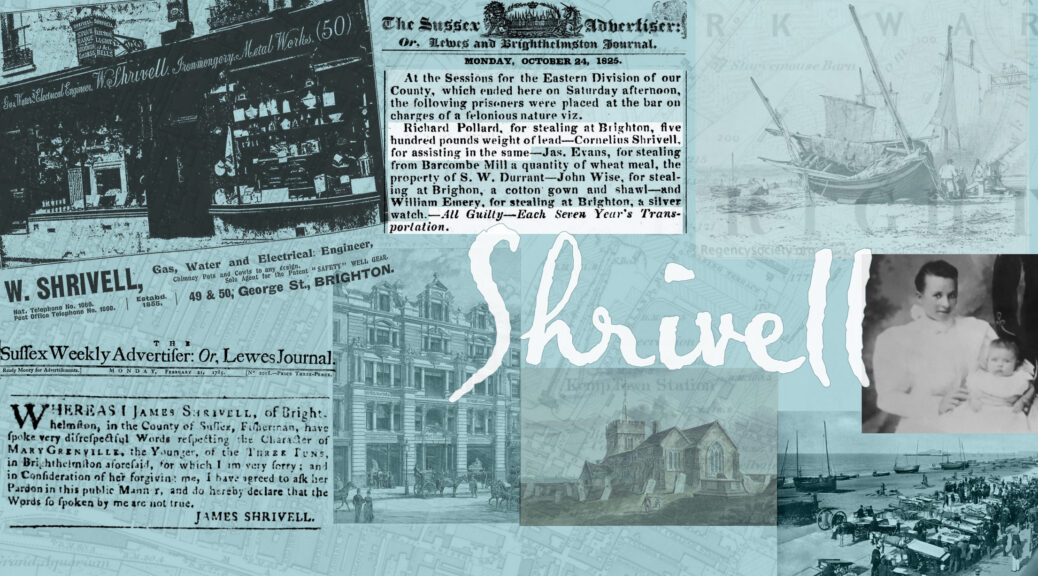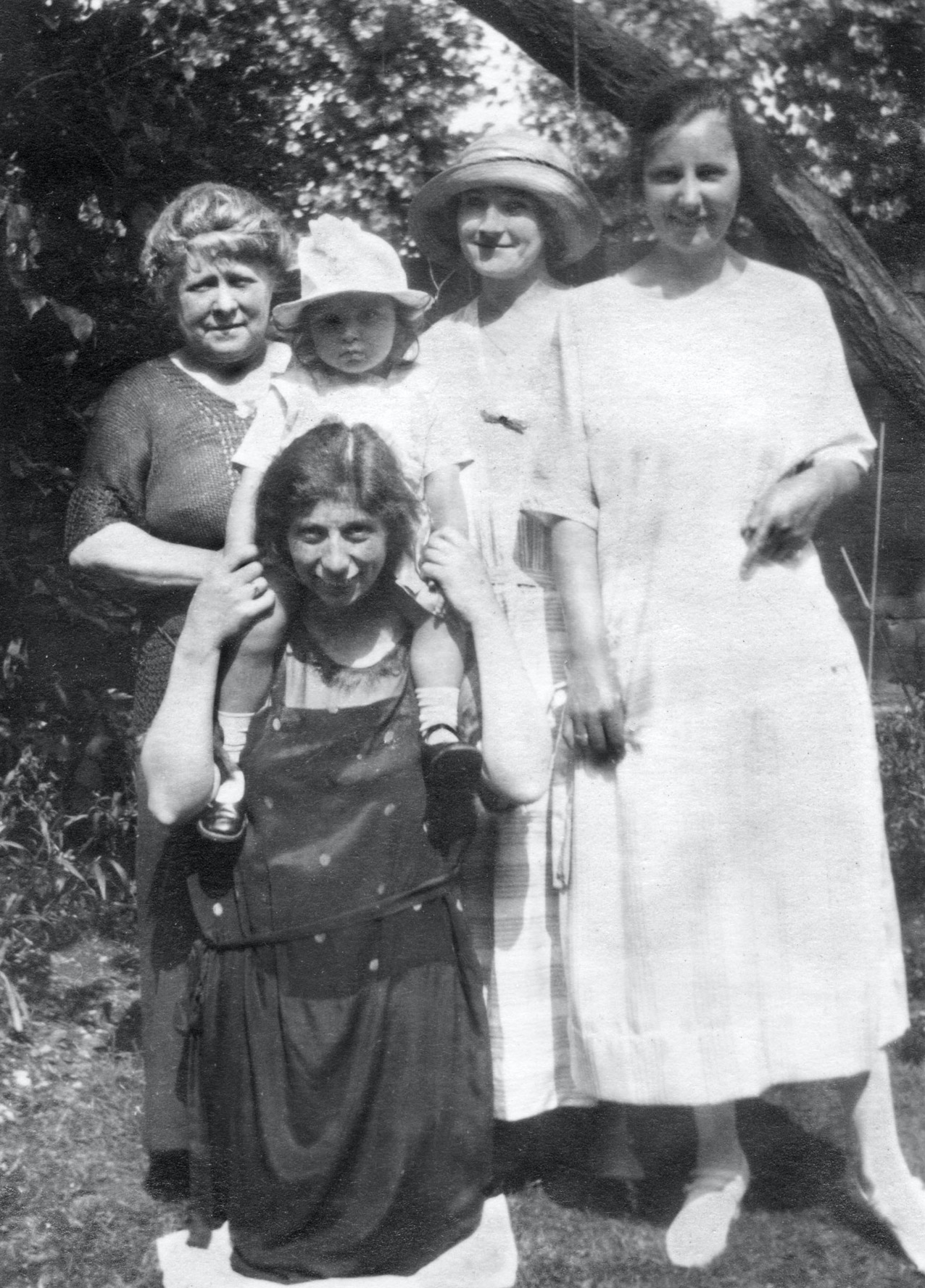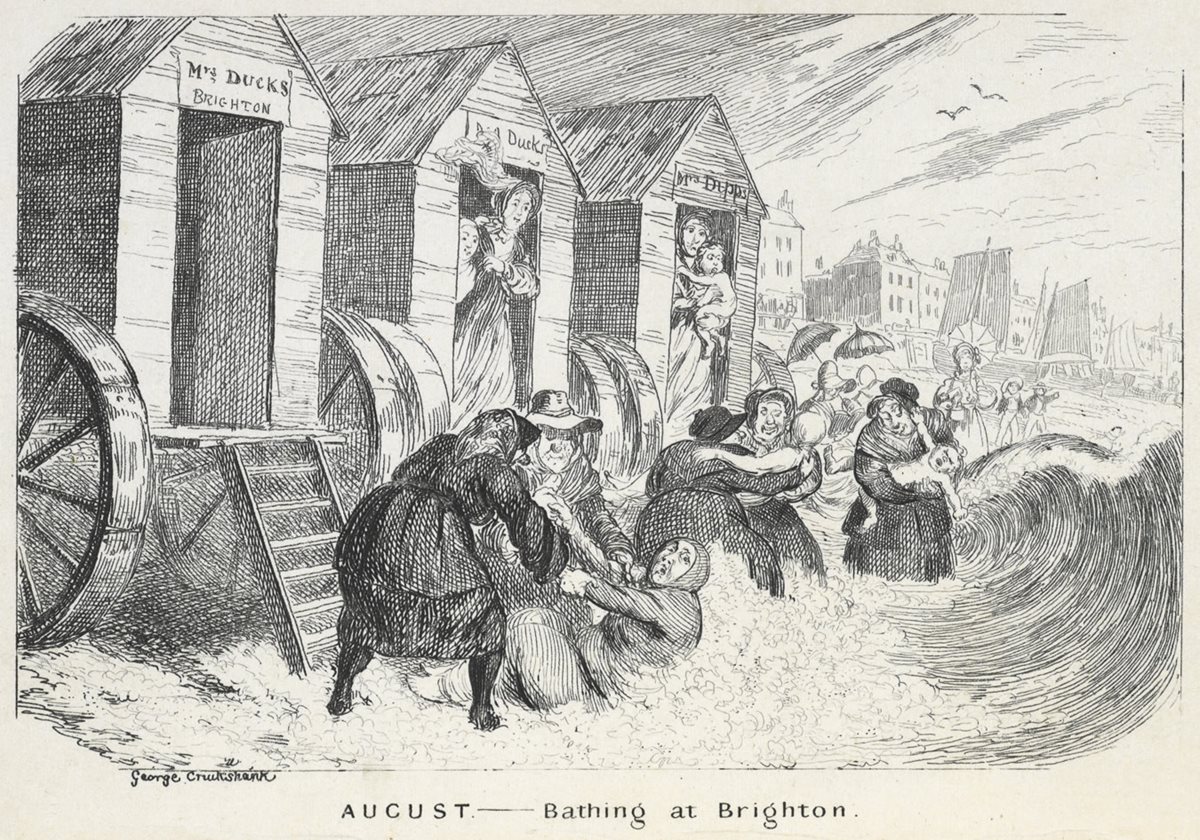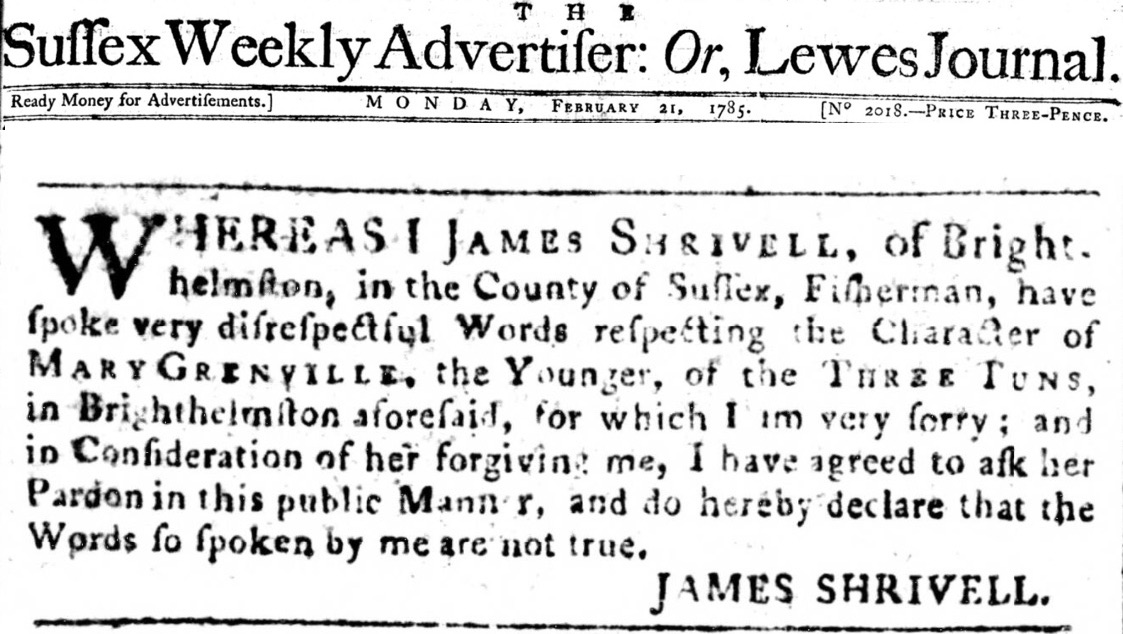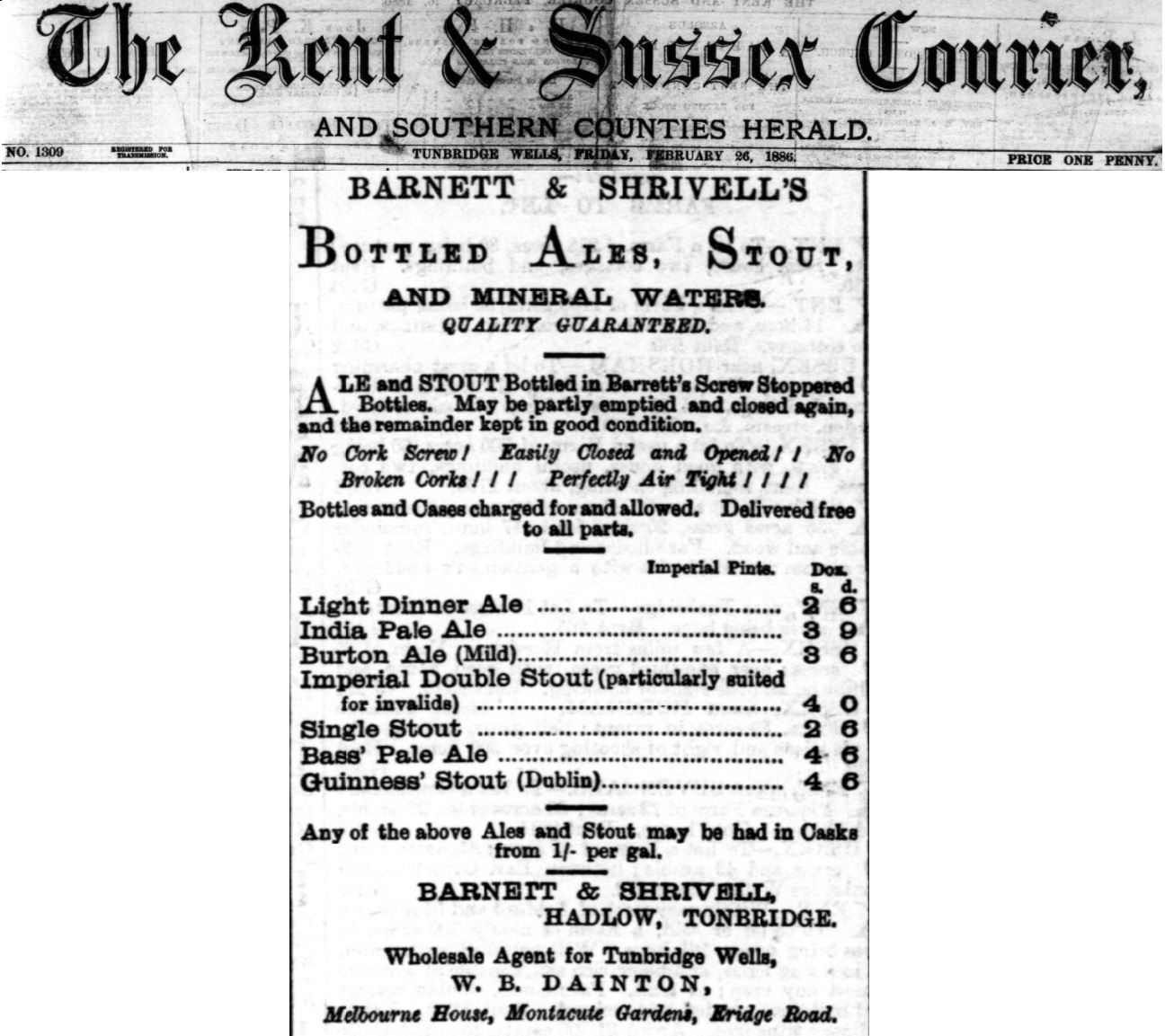I chuckled the first time I heard my paternal great-grandmother’s maiden name – Clara Shrivell. Not a polite thing to do, but she was long dead and my father wasn’t fond of her – described her as the old battle-axe – so my rudeness didn’t start any trouble. The trouble began as I tried to organize the family tree with so many large Shrivell families re-using first names, and living in the same area – Brighton. Before 1841 there was no census to help, and many parish records, most from St. Nicholas Church, are transcript only and missing helpful features like name & profession of father on marriage certificates so you know which Cornelius went with which William (or Thomas, or Robert, or…).
I’ve never met a Shrivell or lived in Brighton. The closest I come is maternal grandparents who retired to Worthing (next town over from Brighton) which we visited many times as children. Legions of retirees taking walks along “the front” – the paved pedestrian path running along the top of the beach – seem in no way connected to the 19th century’s hustle and bustle of bricklayers, ironworkers, watchmakers, servants, fishermen and families crowding the now-demolished cottages near Brighton’s beach. I am intrigued by the stories I’ve turned up about the variety of occupations and types of people. I even found the first example of a relative sentenced to transportation to Australia, along with a mixture of hardworking tradesmen, drunks, petty criminals, one city surveyor and assorted colorful characters.
Brighton was once a small fishing village known as Brighthelmstone; the earliest relative I can identify is my 8th great grandfather, Robert Shrivell, born around 1640. In the late 1700s and through the 1800s, Brighton became very fashionable and much larger – except for the parts of the old village built below the cliffs which washed away in storms. Brighton’s fortunes have soared and faded over time. For my ancestors, think less Royal Pavillion and more Fish Market on the beach.
I’ll start with the Shrivell closest to me – the “old battle axe” Clara Anne Shrivell. Clara is in the post banner image (with her youngest Joe on her lap, around 1901), and at left as a grandmother in Portsmouth around 1920. I touched on Henry Benjamin and his daughter Clara in an earlier blog post, Who were those people in the family tree. Clara was born in Woolwich, where her father, Henry Benjamin Shrivell (2nd great grandfather), was stationed with the Royal Artillery. Henry Benjamin was born in “the old country”, the Shrivell home base in Brighton, in 1835. Henry Benjamin was the 8th of William and Sarah’s 10 children. Bricklayer William Shrivell died when Henry was 14 and everyone still at home had to work – mother Sarah and older sister Ellen as seamstresses, older brother Alfred as a tailor’s apprentice and Henry Benjamin as a solicitor’s clerk. His oldest brother, another Cornelius, had died in 1848, a year before their father. The 1861 census showed Henry Benjamin’s choice – he was a Bombardier at the Woolwich Barracks in London.
Tough circumstances followed the family; Clara was only 9 when her father died (at 45 following an accident getting dragged by a tram). Her mother worked as a dressmaker and took in lodgers to make ends meet until she married again. Clara’s oldest brother Henry joined the Indian Civil Service in the Punjab – he never returned to England, dying in Allababad in 1902 (age 38). Her older brother William, a machine and gun carriage maker, stayed a little closer – Deptford – but died of tuberculosis in 1912 (age 44). Clara married just after her 22nd birthday – a young soldier in the Royal Field Artillery (she lived opposite the barracks) – and six months later was in Felixstowe and a mother (Maisie). Her husband, Ernest Henry Williams, was stationed at the Felixstowe Battery, then moved to Portsmouth (Sis), Fort Ricasoli, Malta (Billie), and finally St. George’s, Bermuda (Dick & Joe). As far as I know, Clara never lived in Brighton and her aunts & uncles were either dead or had moved away when she and Ernest settled in Portsmouth after he left the military and opened a tobacconist shop on Commercial Road. Clara died in Worthing a few years before I was born, but that was as close as she came to the Shrivell home town.
William Shrivell’s father, Cornelius Shrivell (my 4th great grandfather) is one of at least 18 Cornelius Shrivells in the family tree. Such an unusual name, even for the 1800s. Cornelius Vanderbilt comes to mind, but he was the descendant of Dutch settlers in the US and was too young to be an inspiration. Cornelius’ parents chose this puzzling name in 1772 – but his siblings were James, Mary, Thomas, and Richard, more in line with their ancestors. The name stuck around though, as use of Cornelius took off, at least for Shrivells born in the 1800s.
Brighton the fishing village became a social mecca in the late 1700s and early 1800s following Royal visits and a health fad about bathing in the sea. Brighton’s population grew from about 3,000 in 1770 to over 40,000 by 1830 and ~150,000 by 1900; The Royal Pavilion was completed in the 1820s. James Shrivell – apologizing very publicly in 1785 (newspaper article below) – was old Brighton; none of my ancestors were part of the fashionable set. The growth did help those who served the “Royalty, Nobility, Gentry and Clergy” – the first (long) set of Brighton entries in Pigot’s Sussex Directory of 1832 & 1840.
Under “Bricklayers” you’d find Thomas Shrivell, Upper Russel St; William Shrivell, 18 Regent St; “Builders“, Cornelius Shrivell on Mighell St; “Watch & Clock Makers“, Richard Shrivell, 27 King’s Road; “Academies, Seminaries & Public Schools“, Martha Shrivell (boarding and day) 165 Western Road; “Fishmongers“, Shrivell & Co., back of York Hotel. In Kelly’s Directory of Brighton in 1909 there are three listings for Shrivells in the fish sales business – George, Thomas, and Thomas & Sons. I love the address for two of them “Fish Market. The Beach, Brighton“; the third is just “209 The Beach, Brighton” – the beach has numbered addresses!
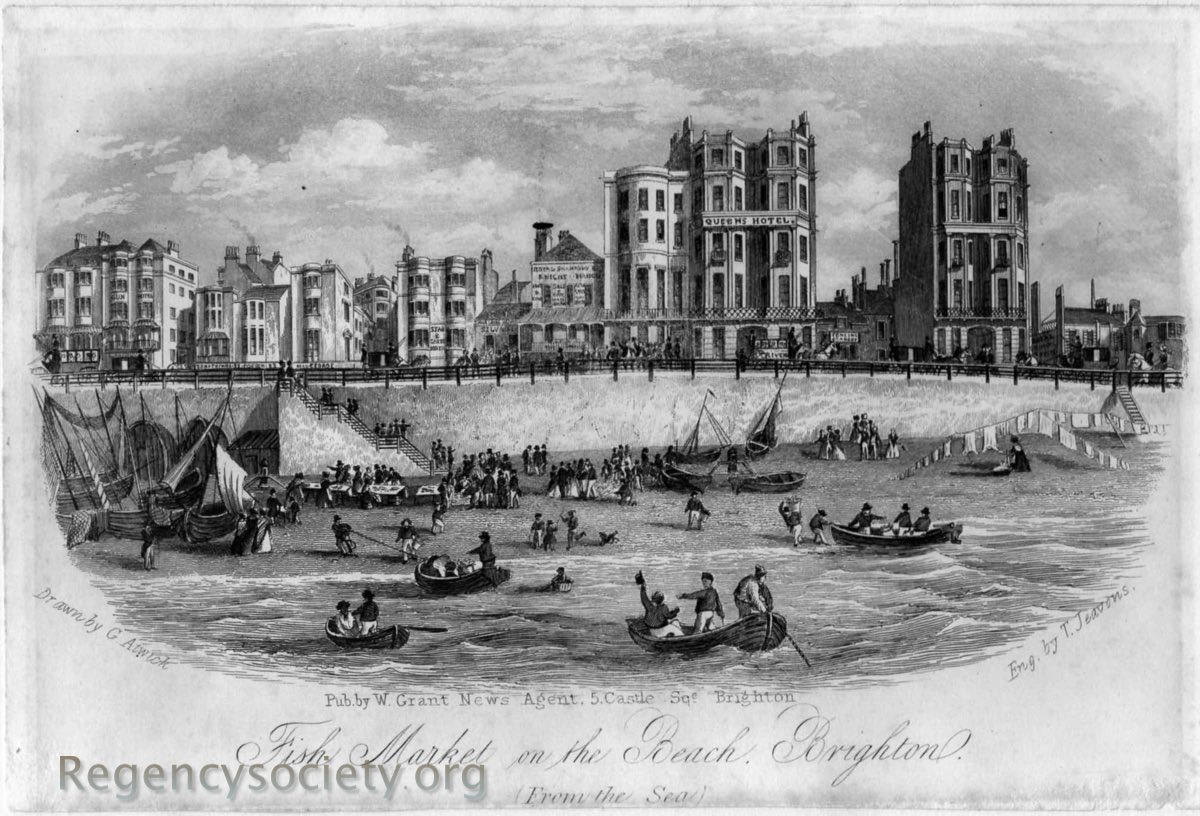
Newspaper stories about the Shrivells were often colorful, though sometimes vague. An 1831 story covered an inquest into the death of a drunk hawker who fell down the kitchen stairs at the Bricklayer’s Arms after being asked to leave. “Mr. Shrivell, the landlord of the house, then requested deceased to quit the room…Mr. Shrivell placed both hands on his back again and gave him another push, which forced him to the outside of the door into the passage…” doesn’t narrow down which Shrivell. There aren’t any newspaper stories or Ancestry records about license renewals either. The hawker’s fall was judged to be an accidental death.
Fortunately, many more stories included names I could match to the family tree. A remarkable public apology at left, titled “WARNING, To the Fishermen and Labouring Men of Brighton.”, featured three Shrivells. The ad from 1811 includes two of James Shrivell’s sons (the apologetic James from the 1785 ad above) and a friend of theirs. The three young men apparently had too much to drink on a Sunday and “fun” looked like assaulting someone’s footman and tearing his clothes. James senior was older, but still capable of obstructing a constable and had to apologize a second time! Can’t miss that the younger lads (they were in their early 20s) hadn’t had much school as two couldn’t sign their names – something increasingly uncommon later in the 1800s as public education improved literacy rates. James senior is my 4th great granduncle and his two sons distant first cousins (5x removed).
In 1842, Cornelius Shrivell and Stephen Marchant were fishing 20 miles offshore when their boat was rammed and split in two by a brig from Limerick; after floating on bits of driftwood for a while they were rescued and offered rum by the Captain “…which speedily restored them.”. In 1825, “Churchwardens vs Shrivell, H. Wells, J. Tattersal, R. Harman and Jeffery” was about a group of young men who “…have greatly misconducted themselves” – putting a rope across a foot path through the church yard to trip people up. Whichever Shrivell it was, was “bound in recognizances to keep the peace”. In 1865, the “fisher-lad” William Shrivel was fined, I think because he wasn’t careful when changing after a swim! The idea that for a long time, swimming at the beach was restricted seemed very strange. Having personally hobbled over pebbles, waded through seaweed and braved the cold, grey, English channel only to get out and try to run back to a towel as the wind brought out huge goose bumps, (a) it’s not for the faint of heart, and (b) I can appreciate the benefits of a bathing machine.
3rd great grandfather William Shrivell’s other children moved away from Brighton, including William Richard and his son William, both metalworkers who set up shop in London. There were a couple of stories in the Illustrated London News about buildings that included the younger William’s work (he’s my 1st cousin 3x removed). Alfred Shrivell became a tailor and furniture dealer, eventually moving to London too.
Edwin Shrivell became a chemist and Postmaster in Hadlow, near Tonbridge, and started a mineral water business, Barnett & Shrivell. The only sibling who stayed in Brighton was a brother Cornelius (also a bricklayer). Much of the Brighton they grew up in – 1820s to 1850s – has been demolished, so only old Ordnance Survey maps show the streets where the various Shrivells lived – Mighell St, Rock St, King’s St, Upper Russell St, etc. The preserved sections are mostly the fancier homes, not the fishermen’s cottages, although the church where so many of them were baptized, St. Nicholas, is still standing.

Given the number of Cornelius Shrivells and some limits on the records available for the earlier ones, I’m not always certain I’ve paired up the newspaper stories to the right relative in the tree. For the earlier dates – this next one from 1837 for example – its a distant connection whether it’s a 4th great grand father or a 5th great granduncle!
Cornelius Shrivell was a builder, on the waterworks commission and a land surveyor who died in 1838. In looking through old newspapers, I found reports of applications for licenses for his premises on Upper Russell Street, denied because there were already so many public houses in a particular area of Brighton. The paper said there were 101 taverns, public houses & hotels licensed by the Brighton Bench in 1832. In one report on license hearings, an objection was that there were already 4 public houses within 150 yards of the one seeking a license. Some objections were from other license holders being direct about how they believe a new pub would hurt their business. Cornelius Shrivell was turned down in 1832 and 1836. The story above made more than the local paper in Brighton because of the suggestion that political influence was at work. Not sure why the dig about his appearance “This portly gentleman applied…”, but I loved the suggestion that he should take action against the magistrate who deceived him for breach of promise!.
The above Cornelius was widowed a few years before he died and married a second time. After his death in 1838, his son-in-law (Benjamin Payne married Cornelius’s daughter Caroline) tried to avoid repaying money he’d borrowed (about £600 in 2021 terms). Amazing that Benjamin was trusted to be one of Cornelius’ executors given the sleazy way he treated this debt, but the widow Shrivell won her case.
On the ne’er-do-well list, but only some of the time, would be Richard Shrivell, a fisherman, who apparently had a drinking problem. In December 1863, the Brighton Gazette praises him for rescuing someone who would otherwised have drowned, at “…considerable risk of his own life.”, but earlier that year he was also fined 5s for being drunk and disorderly. In July 1864, Elizabeth shows a court her bruises and Richard behaves “somewhat outrageously” in Court. Could he have showed up drunk? 14 days hard labor for Richard.
Another creative criminal was the Cornelius ostensibly a shoe black who was actually running off-track betting. No wonder one of the census entries had him “Living on own means”! There were a couple of sad stories about suicides – bricklayer Thomas Shrivell hung himself in 1836 (verdict: insanity) and flyman George Shrivell drank oxalic acid and died in 1866 (verdict: temporary insanity). A fly was a fast, light, horse-drawn passenger cart; he hadn’t been in his job long and was apparently afraid he would be fired. The “aged fisherman” Robert Shrivell was found floating in the sea in 1826. He’d been seen leaving his house three hours earlier – coroner’s verdict “Found Drowned”.
Finally, there’s the Cornelius Shrivell who, with a friend, was convicted of stealing 500 pounds (weight) of lead and sentenced to 7 years transportation to Australia in 1825. I don’t defend theft, but the heavy sentences for property crimes in the 1800s seem really excessive. This wasn’t Cornelius’ first trip before a judge, however, which might have increased the severity of his sentence. In 1823 he and a different friend had been convicted of stealing a silver spoon. “…the property of some person or persons unknown”. That got him two months’ hard labor – but think about what the property description means. The court had no idea whose spoon it was or how he came by it, but reasoned that it couldn’t belong to a 16 year old boy. Clearly you don’t get much due process when you’re a kid from the working class with no money for a lawyer! Undaunted, Cornelius was convicted of larceny again in 1824 – 6 months in prison. Then the trip to Australia. So much for the notion that prison was a deterrent.
Cornelius was held on a prison hulk, York, in Portsmouth, then was shipped to Australia on the Midas on 7 Oct 1826. He arrived 15 Feb 1827 in New South Wales. He was 20, single, could read & write, was 5′ 3-1/4″ tall, had brown hair & dark brown eyes, and was a house painter. He was indentured to the Australian Agricultural Company – well behaved convicts were assigned to farms or families to work. The company was new, founded in 1824, and convict labor was part of the business plan (the company is still in business in 2021). Cornelius’ certificate of freedom was dated 1 Dec 1832. The paper trail runs out after this, sadly, but I’d like to think that Cornelius had turned his life around and stayed out of trouble.
My grandmother, Lillian Melita Williams, probably knew nothing about this colorful family history; I doubt her mother Clara did either. I can only guess at my grandfather’s reaction had he known, given the turmoil and criminal past of his own wastrel father and his wish to put all that behind him. When I get my time machine, I’d love to explore the topic!

